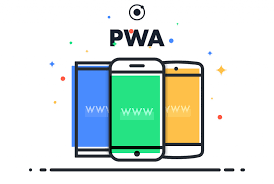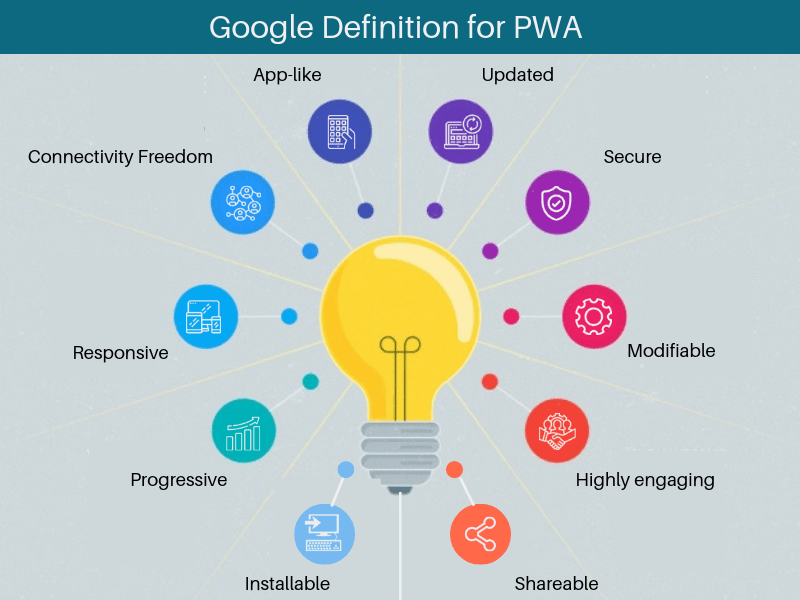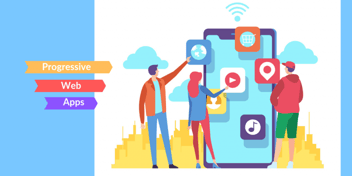5 Best Progressive Web App Examples to Consider

In the fall of 2015, internet giant Google came up with a new method in the app development world called "Progressive Web App" or PWA. The idea was to break the shackles of the limited functionality of mobile applications.
What is PWA exactly?
The core idea behind the inception of PWA is to provide functionality similar to what HTML and web development languages have been providing for years. The PWA focuses on delivering a flawless interface that can be accessed on a browser.
This new approach of development has brought several benefits for both firms as well as individuals who work on mobile platforms and also work for their users.
PWA works on improving the functionality without hampering the existing one with the help of its three key features:
1. Web App installation and accessibility is alike native app.
2. Offline Availability, with it the web app can function without the internet.
3. Push Notifications, web apps can send updates easily.
These features mean that now, customers are the actual users of web apps. According to various data analysis, users get a better experience on an app over browsers. However, they only install apps that are used more on a daily basis, mainly because of the limited storage space.
The progressive web app developer is finding new ways to make a loyal audience, which will invariably provide a good amount of revenue via ads, sales, etc. Moreover, surveys have shown a trend that the majority of customers are from web traffic rather than native app traffic. However, the conversion rate of app is better than the web, which means the reach of the web is more, but its optimization rate is less.
This alarming fact has triggered the mobile app developers to work on the functionalities of PWA to boost the conversion rate of web traffic.
So, how Google has defined PWA

- Progressive – Compatible for every kind of user. No matter what browser you are using, it's developed with progressive enhancement as a core principle.
- Responsive – Modifiable with any form factor: desktop, mobile, tablet, etc.
- Connectivity freedom – Provides the scope to work offline or with weak networks.
- App-like – It gives an app like experience as the app shell model divides the application functionality from application content.
- Updated – It's highly updated because of the service worker update process.
- Secure - Served via HTTPS to avoid snooping and to guarantee data hasn't been damaged.
- Modifiable – It is recognizable mainly due to the W3C manifest and service worker registration scope, which makes it easy for search engines to find it.
- Highly Engaging – It makes the engagement as well as re-engagement process quite smooth via feature like push notifications.
- Installable – It facilitates users to add apps they like or use the most on their home screen without opting for an app store.
- Shareable - With it, it's quite easy to share the application via URL and avoids the complexities of installation.
What makes PWA better than others?
This concept, like other latest web applications, attempts to develop a user experience as close to native apps as feasible. But the main factor that separates it from the other web applications is the fact that it gives an option to work offline, store offline, work under low-quality networks. Moreover, it's highly responsive and progressively improved, you can work on less-capable devices.
Basically, PWAs, with the support of web technologies, can extract the pivotal features of native apps, such as:
• Speed
• Connectivity autonomy
• Data utilization of any type of device
• Synchronization
[pricing_table]
[pricing_column title ="Parameters" size =md]
[pricing_row] Reusability [/pricing_row]
[pricing_row] Knowledge[/pricing_row]
[pricing_row] Pre-styled[/pricing_row]
[pricing_row] 3rd Party Lib. [/pricing_row]
[pricing_row] Popularity [/pricing_row]
[pricing_row] Performance [/pricing_row]
[pricing_row]Native Features [/pricing_row]
[pricing_row]Distribution[/pricing_row]
[pricing_row]Device Support [/pricing_row]
[/pricing_column]
[pricing_column title="Native" ]
[pricing_row]Twice [/pricing_row]
[pricing_row] Learn Twice [/pricing_row]
[pricing_row] High [/pricing_row]
[pricing_row] High [/pricing_row]
[pricing_row] High[/pricing_row]
[pricing_row] High[/pricing_row]
[pricing_row]High [/pricing_row]
[pricing_row]App Stores[/pricing_row]
[pricing_row]Exhaustive [/pricing_row]
[/pricing_column][pricing_column title="Compiled" ]
[pricing_row]Moderate[/pricing_row]
[pricing_row] High [/pricing_row]
[pricing_row] Low to Moderate[/pricing_row]
[pricing_row] Low [/pricing_row]
[pricing_row] Moderate[/pricing_row]
[pricing_row] Moderate[/pricing_row]
[pricing_row] Moderate[/pricing_row]
[pricing_row]App Stores[/pricing_row]
[pricing_row]Limited [/pricing_row]
[/pricing_column][pricing_column title="Hybrid" ]
[pricing_row]High[/pricing_row]
[pricing_row] High [/pricing_row]
[pricing_row]High[/pricing_row]
[pricing_row] Moderate[/pricing_row]
[pricing_row] Moderate[/pricing_row]
[pricing_row] Low[/pricing_row]
[pricing_row] Low[/pricing_row]
[pricing_row]App Stores[/pricing_row]
[pricing_row]Moderate[/pricing_row]
[/pricing_column][pricing_column title="PWA" ]
[pricing_row]High[/pricing_row]
[pricing_row] High [/pricing_row]
[pricing_row]High[/pricing_row]
[pricing_row] High[/pricing_row]
[pricing_row] Moderate[/pricing_row]
[pricing_row] Low[/pricing_row]
[pricing_row] Very Low[/pricing_row]
[pricing_row]URL [/pricing_row]
[pricing_row]Limited[/pricing_row]
[/pricing_column]
[/pricing_table]
Progressive Web App Examples to Consider
Let's check out the companies that optimized PWA to its maximum potential and successfully won the fight for web against the native.
1. Lancôme
Lancôme is a popular French luxury perfumes and cosmetics brand and is part of the L'Oréal Luxury Products division. Although they were getting a good amount of mobile traffic, there wasn't much difference in the conversion rate of its mobile and desktop site.
Hence, to provide a swift and improved mobile web experience, they utilized PWA. It proved to be the right call for them as the company saw a great boost in their sales.
• 17% increase in conversions
• 8% increase in conversions on recovered carts via push notifications
• 15% decrease in bounce rates
• 51% increase in mobile sessions
• 84% less time taken until the page is interactive
2. Settled
Settled is a UK-based real-estate giant that was getting a good amount of traffic to their website via mobile. This forced them to improve the user experience on their website, and hence, used PWA to get a swift, reliable, and appealing mobile experience. And, the results were beyond their expectations:
• 23% increase in conversions
• 8% increase in mobile transactions
• 13% decrease in bounce rates
• 14% decrease in total cost per conversion
3. Pure Formulas
Pure Formulas is a US-based online health and supplement company which was the first one in their sector to utilize the PWA. They mainly used it to repair their cart abandonment as well as conversion rates. Moreover, they also had issues with their sluggish loading pages and tiresome checkout steps. And, the PWA did wonders for them:
• 14% increase in conversions
• 9% increase in Average Order Value (AOV)
• 23% increase in revenue per visit
4. MakeMyTrip
A famous online travel company that invested in the PWA to produce a rapid and appealing mobile web experience. Moreover, they were also facing drop-off rates and client acquisition costs, which were all resolved and improved by PWA.
• 3 times increase in conversion rates
• 38% increase in page load times
• 160% increase in user sessions
5. Pinterest
Pinterest is a popular social media site that utilizes images, recipes, videos, and products. Even such a well-established website faced conversion rate and user engagement issues that forced them to go for a web app development company, which literally saved them.
• 40% increase in time spent on the mobile web
• 44% increase in user-generated ads revenue
• 50% increase in ad click-throughs
• 60% increase in engagement
Other major brands that are now PWA-enabled:
-
Starbucks (U.S.)
-
Tinder
-
Google Maps
-
Uber
-
Lyft
-
Twitter Lite
-
Instagram
There are numerous benefits of PWA: It works on cross-platforms and is easier to maintain. It also needs a lesser investment than a native app. PWA mobility solutions are used to deliver great user experience, a fully functional app with the ease of access to a website.
If you are looking for IT outsourcing services in order to develop an excellent progressive web app solution then you can simply drop up an email at sales@signitysolutions.com or call us at +1-619-309-4653 for a quick discussion with our expert app developers.



.png?width=344&height=101&name=Mask%20group%20(5).png)















